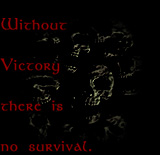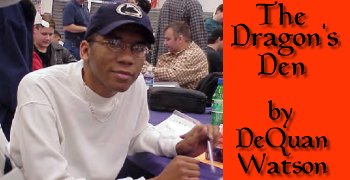|
|
|
|
|
|
|
|
|
|||
 |
||||||||||
|
|
|
|||||||||
 |
|
|||||||||
|
|
||||||||||
|
Watch those curves ...
12.16.04
OK, before the bad jokes get started, this
article isn't referencing the uh...how
should I put it..."girth"...of our larger
gamer brethren. I guess that would be a fun
(and mostly funny) read sometime, but not
today. This is to delve further into the
"curve" of a deck's build.
I know just from e-mails that many of the
more inexperienced players have no idea what
a curve really is when referencing decks and
their builds. Long story short, curve is
simply a term used to described the amount
of cards at each casting cost in reference
to each other.
But even once you understand the "curve"
concept, that doesn't help build a good
deck. You need to also be able to see how
it all fits together. For different deck
types, different cards make up each casting
cost slot.
I know this still isn't totally clear, so
let me break down a curve my deck type.
Weenie Decks (and other fast
creature decks)
The curve on this deck type should
definitely be front heavy. The emphasis
should be on getting creatures early and
just using removal spells to keep your
opponent's permanents out of the way. Also,
because these decks run very little lands,
they must include more small spells.
0 casting cost - 2 casting cost slot
This is where the bulk of the deck is made
up. The number of spells in this category
can sometimes be 30+ spells. Don't fool
yourself though. Part of this reason is
that there is a lot of efficient removal
that fit this category in addition to
creatures. Disenchant, Mana Leak,
Naturalize, Swords to Plowshares,
Reciprocate, and even Terror all fit in
here.
3 casting cost - 4 casting cost
For a quick creature deck, I generally refer
to anything in this spot to be clinchers.
Spells such as Glorious Anthem or Armageddon
can fit this slot. Spells here should be
solid support to your early creatures. If
nothing else, there should be something in
this slot that forces your opponent into a
do or die turn if you can. Because you may
end up with some trouble casting these
spells, they need to be strong when they
hit. Usually this is no more than six slots
or so for this deck type.
5+ casting cost
This is obviously where this deck type
doesn't really want to be casting spells.
If you must, this slot just becomes backup
spells. These are usually big creatures
that help you recover from a Wrath of God or
help you fight your opponent's problems guys
in long games. Something like Serra Angel
generally fits this slot. However, this
usually won't make up more than one or two
cards here.
Control Decks
Control decks try to draw the game out.
These decks tend to be a little heavier on
the back end. However, that can also come
down to what cards are available in a given
format.
0 casting cost - 2 casting cost
Cards in this slot are setup spells. These
are there to help set the tone of your next
few turns and for the game. Spells in this
slot are there to get you a few lands. Some
will slow your opponent down. Spells like
Counterspell and Terror are perfect here.
Spells such as Night's Whisper and Serum
Visions generally find their way into this
spot as well.
3 casting cost - 4 casting cost
These are the stabilizers for a control
deck. If the deck plays any creatures, the
bulk of them will fall here. These are
creatures that have some good "comes into
play" abilities usually. Also, this is
where the true control cards that start
setting your opponent back hit the table.
5+ casting cost
Of the various deck types, this one is
likely to have the most cards in this slot.
Decks like Tooth and Nail abuse big spells
here and have 10+ cards in this slot
sometimes. However, there are other card
such as Death Cloud and such that basically
fall into this slot as well. Also, the big
finisher creatures all fit here. Dragons,
angels, and even Memnarch and some in to bat
clean up in a control deck.
Combo
Of all the deck types, this one is probably
the most balanced among the casting cost.
There obviously isn't total equilibrium
between them all, but usually more so than
other decks. This can be for a variety of
reasons depending on the deck.
0 casting cost - 2 casting cost
From the get go, control decks want to start
hunting for combo pieces. Spells in this
slot generally draw cards and or search out
particular cards. If they don't do that,
they are usually accelerating the mana base
of the deck. Combo decks have a limited
umber of turns to get to business, so there
don't even usually waste slots on removal
spells here. It's just all business all the
time.
3 casting cost - 4 casting cost
Spells here are many times, creatures with
the key ability or enchantments that are key
to the combo at hand. These spells can
start hitting the table in multiples if the
early game went well. If the combo player
gets to have his way, these spells will even
hit on turn two, which is great, because it
allows them to technically skip a turn of
spell casting.
5+ casting cost
These spells are the closers for the combo.
These are usually the finishers that have
double duty. Something along the lines of a
Fireball or Stroke of Genius can be used to
help push things through if the combo breaks
down. In some cases they can be used to by
you time to get to key pieces.
Looking over these, I just came to another
realization. This is a decent article for
players not understanding how some decks
need to be built. There is a lot to be
learned in the ways of deck building. The
biggest thing that effects all the parts of
a deck is simply the cards that are
available. It's important enough that one
new set can sometimes shift an entire
metagame.
Well, that's my time for this week. Pay
attention to the curve of your deck and your
opponent's decks next time. You will be
surprised what you can learn. And if
nothing else, you can clean your deck up a
little.
Until next time
DeQuan Watson
a.k.a. PowrDragn
PowrDragn at Pojo dot com
|
|||||||||

